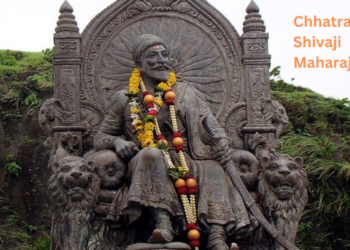Chhatrapati Sambhaji Maharaj (1681-89), the second Chhatrapati of the Maratha Empire, was a fearless warrior, an able administrator, and a staunch protector of Hinduism. Born to the legendary Chhatrapati Shivaji Maharaj (1674-80), he played a crucial role in continuing his father’s legacy and defending the empire against the mighty Mughal forces. Despite facing immense challenges, Chhatrapati Sambhaji Maharaj exhibited unparalleled bravery, making him one of the most iconic figures in Indian history.
Early Life and Education
Sambhaji Bhosale was born on 14 May 1657 at Purandar Fort to Shivaji Maharaj and Saibai. From an early age, he received rigorous training in warfare, administration, and governance. He was well-versed in Sanskrit, Marathi, and Persian, showcasing his scholarly abilities along with his military prowess. His upbringing under the guidance of experienced mentors prepared him for the challenges of ruling an empire.
Accession to the Throne, 1681
After the demise of Shivaji Maharaj in 1680, a succession crisis emerged within the Maratha Empire. Despite internal opposition, Sambhaji Maharaj ascended the throne in 1681 at the age of 24. His reign was marked by continuous battles against the Mughal Emperor Aurangzeb, the Portuguese, and the Siddis of Janjira.
Military Strategy of Chhatrapati Sambhaji Maharaj
1. Guerrilla Warfare and Mobility
Following the principles established by Chhatrapati Shivaji Maharaj, Chhatrapati Sambhaji Maharaj employed advanced guerrilla tactics to counter larger and more structured armies. His forces relied on swift attacks, ambushes, and surprise assaults to weaken enemy morale and logistics. The rugged terrain of the Sahyadri mountains provided a strategic advantage, allowing Maratha forces to move swiftly and evade pursuit.
2. Naval Power and Coastal Defense
Understanding the significance of coastal security, Sambhaji Maharaj strengthened the Maratha navy. He maintained control over key ports and engaged in maritime warfare against the Siddis of Janjira and the Portuguese. His naval strategy involved blockading enemy supply lines and launching seaborne raids, which disrupted trade routes and weakened enemy strongholds.
3. Multi-Front Warfare
Chhatrapati Sambhaji Maharaj faced threats from multiple adversaries, including the Mughals, the Portuguese, and the Siddis. His ability to conduct warfare on multiple fronts showcased his strategic brilliance. He ensured that no single enemy could focus all their efforts against the Marathas by constantly shifting his military campaigns across different regions.
4. Psychological Warfare
Chhatrapati Sambhaji Maharaj understood the power of psychological warfare. He instilled fear among his enemies by launching relentless attacks and displaying unwavering resistance. His refusal to surrender to Aurangzeb, despite brutal torture, became a symbol of Maratha defiance and inspired his followers to continue the fight.
5. Diplomacy and Alliances
While primarily a warrior, Sambhaji Maharaj also engaged in diplomatic efforts to strengthen his position. He sought alliances with regional rulers to counter the Mughal onslaught and maintain Maratha influence in southern India. His strategic partnerships helped the Marathas survive and regroup after his martyrdom.
Military Campaigns and Achievements
Sambhaji Maharaj was a fierce warrior who expanded the Maratha Empire and defended it against external threats. Some of his notable military campaigns include:
- Resistance Against Aurangzeb: Sambhaji Maharaj fought valiantly against the Mughal forces led by Aurangzeb, preventing them from taking control of the Deccan region.
- Battle Against the Portuguese: He launched several attacks on Portuguese territories in Goa, resisting their expansion in India.
- Naval Warfare: Sambhaji Maharaj strengthened the Maratha navy to counter the Siddis of Janjira, ensuring the security of coastal regions.
- Southern Expeditions: He expanded Maratha influence in Karnataka, Tamil Nadu, and Andhra Pradesh, strengthening the empire’s southern frontiers.
Administrative and Cultural Contributions
Apart from his military skills, Sambhaji Maharaj was a visionary ruler who implemented several administrative reforms. His contributions include:
- Religious Tolerance: He protected Hinduism from forced conversions by Mughals while respecting other faiths.
- Encouragement of Literature: Sambhaji Maharaj was a scholar and patron of arts. He authored “Budhbhushanam,” a Sanskrit text highlighting his intellect and literary interests.
- Efficient Governance: He strengthened the administrative framework laid by Shivaji Maharaj, ensuring economic stability and efficient governance.
Capture and Martyrdom
In 1689, Chhatrapati Sambhaji Maharaj was betrayed by his own men and captured by Mughal forces. Aurangzeb offered him a choice: convert to Islam or face execution. Sambhaji Maharaj refused to surrender his faith, enduring brutal torture before being executed on 11 March 1689. His martyrdom became a symbol of resistance against tyranny and oppression.
Legacy and Impact of Chhatrapati Sambhaji Maharaj
Chhatrapati Sambhaji Maharaj’s bravery and sacrifice continue to inspire generations. His unwavering commitment to the Maratha Empire laid the foundation for future rulers like Chhatrapati Rajaram and the eventual rise of the Peshwas. Today, he is revered as a symbol of patriotism, valor, and unwavering devotion to his people and faith.
Conclusion
Chhatrapati Sambhaji Maharaj was not just a warrior but a true embodiment of courage, intellect, and leadership. His contributions to the Maratha Empire and his fearless resistance against the Mughals make him an unforgettable hero in Indian history. His legacy continues to be celebrated through literature, folklore, and public commemorations, ensuring that his story remains alive for generations to come.
Sources:
Gazeetter, Government of Maharashtra
Chhatrapati Shivaji Maharaj Museum in Mumbai
CSEguide.com article on Chhatrapati Sambhaji Maharaj, 1657-89


